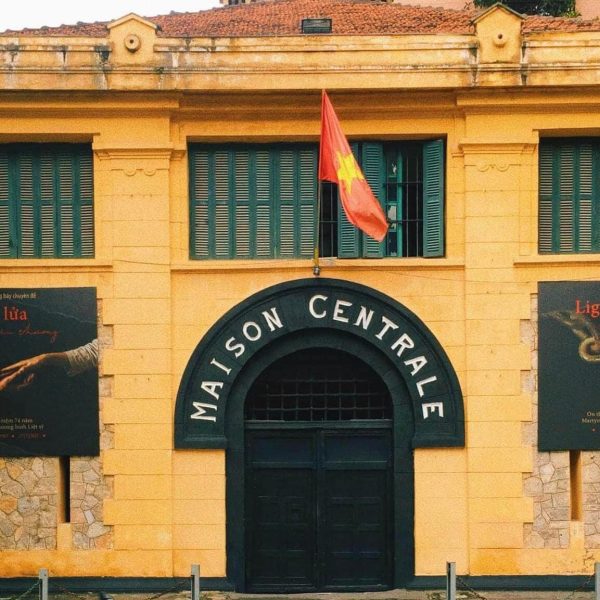Hoa Lo Prison: A place well worth a visit on your trip to Hanoi Vietnam
During your Hanoi travel journey, besides enjoying exquisite Vietnamese traditional food, visiting Hoa Lo Prison should be one of the top activities on your bucket list. Coming to this historical relic, you will have an opportunity to gain a greater insight into the life of Vietnamese revolutionaries during the First Indochina War. This article will provide you with interesting information about this significant Hanoi historical site.
1. Where is Hoa Lo Prison Hanoi Vietnam? How to get there?
- Address: No. 1, Hoa Lo Street, Hoan Kiem District, Hanoi
Having a prime location in the heart of Hanoi, Hoa Lo Prison is just about a 15-minute walk away from Hoan Kiem Lake. Thus, tourists can easily reach this attraction from any part of the city. There are some popular means of transportation to choose from, including public bus, motorbike, taxi, and car.
If you want to take the bus, you can catch buses number 2, 9, 40, 49, which all make a stop near the prison. In case you have a vehicle, parking is available at the entrance of Hoa Lo Prison.
- Hoa Lo Prison opening hours: From 08:00 am to 05:00 pm every day (including holidays)
- Hoa Lo Prison entry fee: 50,000 VND/person
2. Learn about the dark history of Hoa Lo Prison Hanoi
When Vietnam was still a part of French Indochina, the French began constructing Hoa Lo Prison in 1896 and finished it in 1901. The prison was initially named Maison Centrale, which was a common euphemism for French prisons. The prison was used to lock up political prisoners fighting for independence in the war. By 1954, it housed almost 2,000 inmates, who were shackled to walls by the dozen and lived in appalling conditions. Several Vietnamese revolutionaries were put under the barbarous guillotine, which the French had used throughout the region.
An old picture of Hoa Lo Prison
After the French were driven out of Hanoi in 1954, the prison was converted into a Vietnamese facility. From 1964 to 1973, several American pilots captured during the Second Indochina War were held here, including senator John McCain and Douglas Peterson, the first ambassador to post-war Vietnam. The inmates of Hoa Lo were gradually released when the war was coming to an end.
For the next 20 years, the prison kept political insurgents in custody. In 1990, it was closed and mostly demolished to make way for high rise construction in the growing Hanoi.
3. Explore the special structure of Hoa Lo Prison
Once regarded as an unbreakable prison in Indochina, Hoa Lo Prison was surrounded by walls of 4 meters high and 0.5 meters thick, which were encrusted with broken glass and barbed wires powered by high voltage electricity. There are four watchtowers placed at four corners of the prison, so the wardens could monitor every single action of the prisoners.
 The terrible living conditions of Vietnamese revolutionaries in Hoa Lo Prison
The terrible living conditions of Vietnamese revolutionaries in Hoa Lo Prison
Covering an area of 12,000 square meters, the inside of Hoa Lo Prison was divided into different areas, including a guard house, a medical house, an iron and textile making house, and seven houses for accused prisoners. There was also a terrible place known as the cachot, which was used to confine those with opposing behaviors or violent criminals. The cachot was regarded as the worst of hell due to its lack of light, air, and space. It was truly a nightmare to all Vietnamese prisoners at that time.
4. What to explore in Hoa Lo Prison nowadays?
Visitors to Hoa Lo Prison will have an opportunity to see exhibits that show the prison’s history in two different periods. The first period is from when French colonialists erected the prison in 1896 until the liberation day of Hanoi (October 1954). The second period is from 1964 to 1973, when the Vietnamese government used a section of the prison to house American pilots.

The French guillotine at Hoa Lo Prison Museum
Inside the prison, you will see an ominous French guillotine, horrifying iron shackles, brutal torture instruments, as well as statues of captives wearing leg chains. The Vietnamese prisoners were mercilessly tortured and beaten on a daily basis by the guards here. Tortures included electric shock, upside-down hanging, and bad rice feeding. This prison will enhance your perspective, understanding, and appreciation for the revolutionary fighters’ spirit, as well as the Vietnamese people’s humane approach toward American prisoners during the war.



